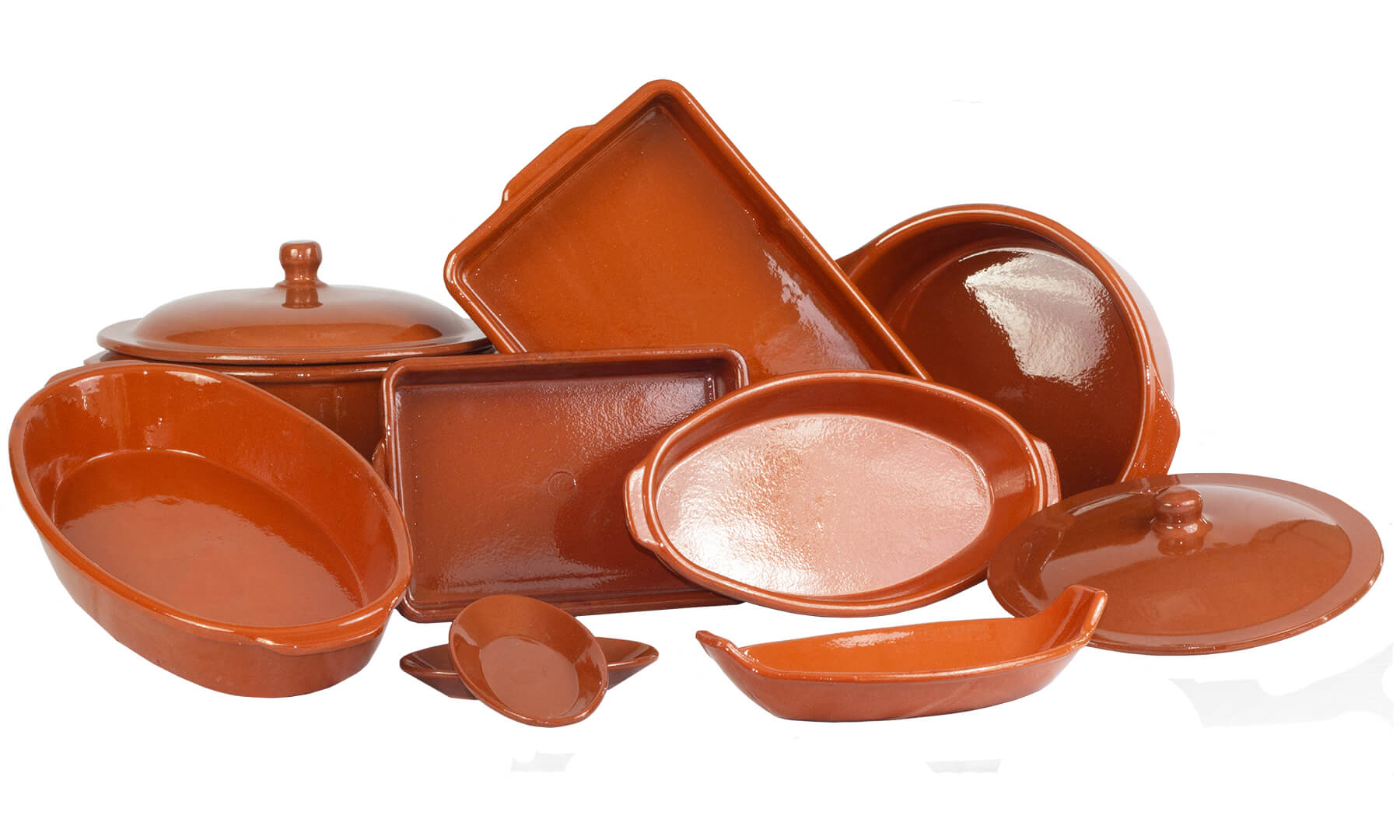Terracotta bakeware has been used for centuries across many cultures and the Spanish make some of the best! Our manufacturing partner has been producing terracotta for over 100 years! Terracotta comes in two styles, and Forno Bravo only sells the higher-quality, “stoneware” variety. Terracotta cooking pots are called “Cazuelas” in Spanish.
Cooking in terracotta results in a moist, even heat that remains in the pan long after it is taken from your oven, helping to keep food warm. The pans can also be used for frying, roasting, or casseroles. The clay can retain and transmit flavors between meals, so many people prefer to cook sweet and savory items in different pots. Very fine cracks (crazing) can form in the glaze inside your pot over time. These are not defects, but allow the water’s microvapors to be released into the food during the cooking process.
Following are recommendations for seasoning/curing your terracotta cookware for years of cooking pleasure.
Step 1 – Receiving Your Terracotta
Upon receipt of your terracotta, it may be tempting to start cooking! However, it will first need a little care. Your cookware will be coming to you much as it left the production factory in Spain. Unseasoned terracotta pots are more fragile than seasoned ones. When your terracotta arrives, the best thing to do is start running the tap.
Notes: Larger dishes and deeper casserole pots may not fit in the sink for soaking, due to their size and circumference (see step 2 below.) In these cases, a bathtub or large plastic bucket are the best solutions, as each piece needs be fully submerged in water.
Step 2 – Wash and Immerse in Water
First, wash the pan thoroughly in warm water. Do not use detergent or soap, as this may block the delicate pores in the clay. Next, completely submerge the pot in room temperature water.
How long your terracotta pan needs to be immersed in water varies. The general rule is the longer the better, particularly for larger pieces. Water ‘cures’ the terracotta and needs time to soak-in effectively, which will add both strength and weight. Our suppliers recommend at four to 12 hours of soaking for larger, thicker pans, and two to four hours for smaller pieces, up to 6″ in diameter. The pan will absorb a considerable amount of water. Even if your casseroles are destined for cooking purposes straight away, a good soaking is always recommended, as it will ‘toughen up’ your terracotta for more durability and a longer lifespan.
Notes: Although our terracotta cookware is fired at quite high temperatures, unless it is soaked, it could suffer from ‘thermal shock’, which may result in cracking.
Step 3 – Heat It Gently
Once your pans and lids have been soaked in water, drain and wipe them dry. They are now ready to be introduced to heat. For the initial heating, fill your terracotta pot with water to just below the rim and heat gently it on the stove or in the oven, turning up the heat very gradually to bring the water to a boil. Let the liquid boil down until about only a half cup remains. Cool slowly and rinse. (Use a flame-diffuser if heating the pan on a gas stove. A diffuser is not required on electric ranges.)
Notes: Spanish terracotta cookware can become extremely hot, so handle it with care during and after cooking. Terracotta also has extremely good insulating qualities and will keep food hot longer than other cookware. When serving food in terracotta, it is worth keeping in mind that the piece will remain hot for longer than expected, even if it has been on the table for some time!
Be sure to use oven mitts when handling the pan, and place the pan on a trivet, wooden board, or folded towel after removing it from your oven. Placing a hot pan on a cold work surface can cause cracking.
Step 4 – Cooking
Your pan has now had its first seasoning and is ready for use. The process of immersing it in water only needs to be done once (not each time it is used,) though you can briefly rinse the pot and lid prior to each use to get it wet. Cooking in the casserole pan will continue to season and cure the terracotta, so the more you enjoy cooking in your clay dishes, the longer they will last.
Notes: Do not put cold food straight into a hot terracotta pan unless you have heated some oil in the bottom first. (Again, you are trying to avoid thermal shock.)
Step 5 – Washing and Storage
After using your casserole pan, we recommend washing your terracotta by hand, although it can be placed in the dishwasher. Always allow the pot to cool before putting it in cold water. Avoid abrasive scourers. Instead, use a little baking soda with a soft brush or sponge to clean the pan. For more stubborn marks, soaked the pan in soapy water for as long as necessary. Rinse well and allow it to air dry completely before storing. Do not leave the lid on the pan when storing it in the cupboard. (You want air to circulate to prevent mold if it is not 100% dry.)
Visit our Community Cookbook for several recipes that cook beautifully in your new terracotta bakeware!
See our Online Store for other sizes and styles of terracotta pans to add to your collection!

Glazed Terracotta Bakeware from Spain




